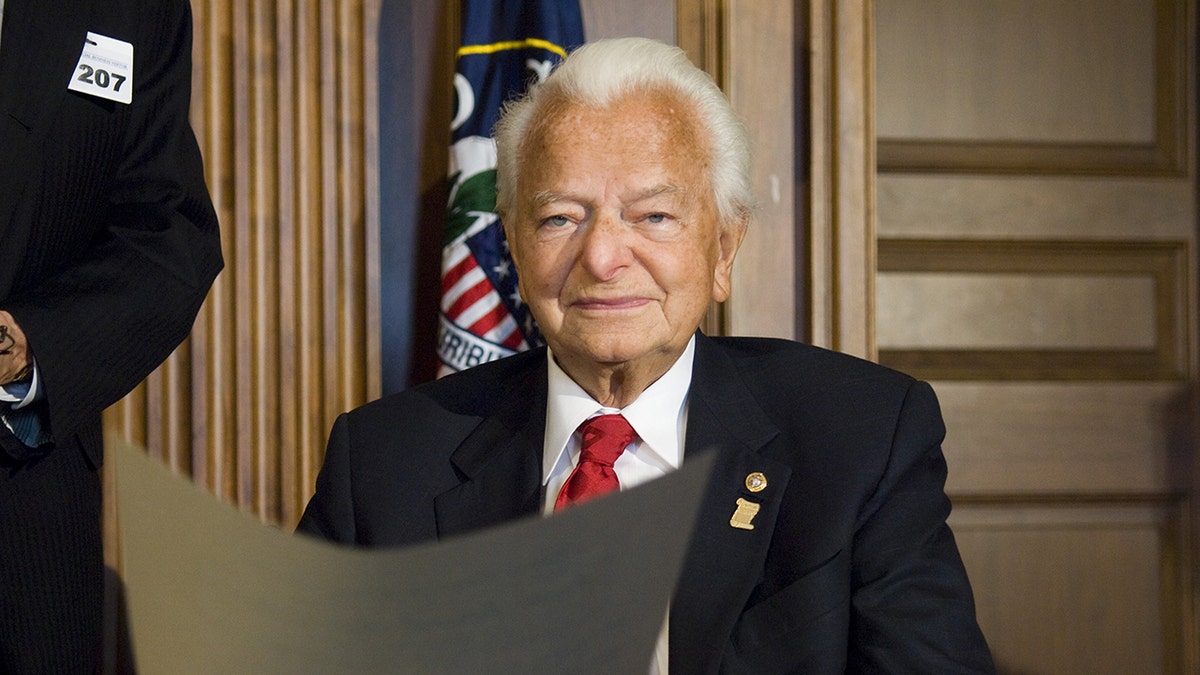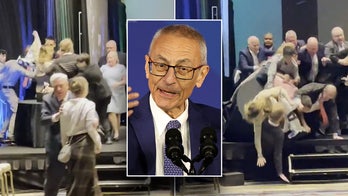Fox News Flash top headlines for December 6
Fox News Flash top headlines are here. Check out what's clicking on Foxnews.com.
Everyone on Capitol Hill is chirping about the "Byrd Bath" and "Byrd Rule."
"The question is, would that meet the Byrd Rule?" asked House Speaker Nancy Pelosi, D-Calif., at a recent news conference when speaking about the Democrats’ social spending package.
"The bill will need to go through what is known as the Byrd Rule," said Rep. Ayanna Pressley, D-Mass., during a meeting with constituents.
CONGRESS FLIRTS WITH DEBT CEILING COLLISION, ANOTHER CLOSE ENCOUNTER: REPORTER'S NOTEBOOK
"We know that it has to meet both the ‘Byrd’ and privilege," said Rep. Sheila Jackson Lee, D-Texas, during a scrum with reporters in a Capitol hallway.
So, before you give this story "the bird"…. let me give you a Byrd’s-eye view, instead.
The contours of the Democrats’ $1.75 trillion social spending bill hinge on an ornithological, Senate scrubbing. It’s referred to as the "Byrd Bath." This peculiar process dictates the scope of the "Build Back Better" bill. What’s in and what’s out. The very shape of the legislation.
For starters, note that it’s spelled "B-Y-R-D" and not "B-I-R-D." This Senate process has nothing to do with ablutions - but everything to do with parliamentary procedure. The bizarre, Senate folkway is named after late and legendary Senate Majority Leader Robert Byrd, D-W.Va.
"He’s not just some guy. He's not just some senator. He was ‘Mr. Process.’ He was ‘Mr. Institution.’ He was ‘Mr. Soul and Integrity’ of the body," said former Senate Parliamentarian Alan Frumin. "You don’t mess with Byrd. He was, you know, the alpha and the omega of the Senate’s institutions."

The late Sen. Robert C. Byrd, D-W.Va., seen here in a file image. (Scott J. Ferrell/Congressional Quarterly/Getty Images)
Byrd died in 2010 after serving more than 51 years in the Senate. He is the longest-serving senator in American history.
"If one knows the rules and precedents, he has the Senate in his hand," boasted Byrd during a 1989 C-SPAN interview.
A deep knowledge of Senate procedure was Byrd’s hallmark. Byrd knew if he understood the process, he could block rival senators. The result was scoring legislative victories on policies he wanted – and jamming up the others.
"I knew the rules about as well as anyone who ever walked in here," said Byrd to yours truly in a 2006 interview. "And I knew how to use them, too."
"Budget reconciliation" is a term you hear around Capitol Hill these days. It is a byproduct of the Budget Act of 1974. The measure codified the current budget process in Congress.
A few years later, senators got creative. They discovered a loophole in the Budget Act. They could sidestep filibusters (which require 60 votes to overcome) and pass bills via budget reconciliation. All you need on a budget reconciliation measure is a simple majority in the Senate.
Always the institutionalist, Byrd wanted to erect some guardrails. He perceived using budget reconciliation to skirt Senate rules as an abuse of process. By the mid-1980s, Byrd convinced 96 of his colleagues to support an amendment which was codified into law. This became the "Byrd Rule."
The Byrd Rule dictates that when using budget reconciliation, senators must demonstrate that their provisions are linked to the budget. Those measures must be fiscal in nature and deal with taxation.
The Senate has a special way to cleanse budget reconciliation bills to assure that they qualify for the fiscal framework of budget reconciliation. That’s the "Byrd Bath."
Interested parties (usually Senate aides) appear before the Senate Parliamentarian to make their case as to why a provision meets the parameters of reconciliation - or to argue against it. Senate Parliamentarian Elizabeth MacDonough considers those proposals and decides what’s in or out. What’s fish or fowl. Or, perhaps - foul. A decision by the parliamentarian could clip the wings of legislative language which does not align with the Byrd Rule.
"People always want the parliamentarian to say yes," said Frumin of legislative entreaties. "And they want the parliamentarian to say yes yesterday."
CONGRESS HAS SEVERAL MUST-GIVE PACKAGES TO DELIVER BY CHRISTMAS
Now, here’s something important to remember:
The Byrd Bath is not a ceremony. It isn’t a formal meeting like a hearing or a Senate committee markup. It’s more process than pageantry. Sometimes it’s phone calls, sometimes emails, sometimes short meetings, sometimes someone sticking their head into the office of the parliamentarian and asking a question. It is exchanges of paperwork and emails. It’s a more casual Senate construct as senators and their staff attempt to get guidance as to what is accepted.

The Capitol is seen at dawn in Washington, on Election Day 2021. (AP Photo/J. Scott Applewhite)
"It’s usually a ‘yes’ or ‘no,’ face-to-face with somebody in the office or a brief phone call," said Frumin. "It is rarely something that was committed to in writing in the form of a formal opinion."
But there is an exception.
Sometimes provisions are so controversial that the parliamentarian convenes the sides in a Senate room, complete with tables and chairs arranged as though they are arguing a case in a court of law. Such was the case more than a decade ago when Senate aides pleaded their arguments on Affordable Care Act provisions. They met in the ornate Lyndon Baines Johnson Room of the Capitol.
"One of the more contentious Byrd rule discussions that I participated in circled around a provision in the Affordable Care Act where we actually had written legal style briefs of the sort that you might see in a U.S. Court of Appeals," said Rohit Kumar, a former top aide to Senate Minority Leader Mitch McConnell, R-Ky., now at the PWC National Tax Office. "We had oral arguments, not unlike the Court of Appeals ruling."
WHY IT TAKES CONGRESS SO LONG TO ACT
"That is the ultimate in a Byrd Bath scrubbing. Have the two sides together," said Frumin. "You get a conference room and have the parties sit around the table at the same time."
Kumar compared the process to "litigating." He said a favorable ruling for the GOP "would have probably taken the entire bill down."
Most aspects of the Byrd Bath are "technical," says Kumar. He likens the process to "working the refs" in basketball or football.
"You want to make sure you get a ruling on an issue in a way that is clear that will be available to you down the road," said Kumar. "You’re working the refs to get the next call to go in your favor."
Provisions which don’t survive the Byrd Bath are called – ahem – "Byrd Droppings." And if the Parliamentarian rules against you, that ruffles Senate feathers.
"They hold grudges," said Frumin of those who pushed for provisions which he nixed. "It’s remarkable how the beneficiaries of the parliamentarian’s advice have short memories and those who feel slighted never forget."

Speaker of the House Nancy Pelosi, D-Calif., recently made reference ot the "Byrd Rule." (AP Photo/J. Scott Applewhite, File)
Rarely do senators themselves seek an audience with the Senate Parliamentarian when it comes to wedging a particular provision into a reconciliation package. But Frumin remembers one instance where a covey of senators made a splash during an especially contentious Byrd Bath – overseen by the late Parliamentarian Bob Dove.
For the record, it’s not required that the person in charge of the Byrd Bath carry an avian surname.
Frumin says the gaggle of senators crowded around Dove in his office – practically trying to physically intimidate him. Frumin said the flock of senators backed Dove up against a fireplace in his Capitol office.
"There was a looming, physical presence," said Frumin. "I’ve never seen that level of Senate pressure lodged against a parliamentarian."
But Frumin said Dove didn’t budge.
"It was a remarkable scene," said Frumin. "(Dove) actually retreated as far as he could physically and he stuck to his guns."
Perhaps one could describe that as "Byrdshot."
CLICK HERE TO GET THE FOX NEWS APP
But efforts to cram various provisions into reconciliation bills are an intense process.
Pro-immigration demonstrators even shut down the Golden Gate Bridge in September. They unfurled a banner reading "Override the Parliamentarian."
The Senate isn’t bound by the behind-the-scenes Byrd Bath. But if senators want to ignore the Byrd Rule, 60 votes are necessary to say "Bye Bye Birdie," and ignore it.
If certain provisions don’t survive the Byrd Bath, the entire bill may never take flight.







